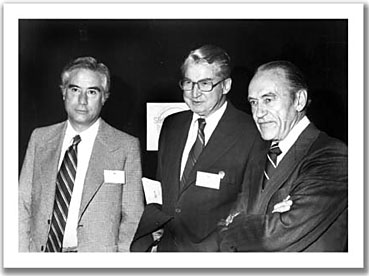|
5
Contributions to Neurosurgery
Dr Rasmussen contributed to important aspects of neurosurgery. In addition to the surgery of the
pituitary gland and treatment of pain, he carried out experimental studies on cerebrovascular problems and reported
on tumors of the brain and spinal cord. He substantiated the application of the carotid-amytal test introduced by
Juhn Wada so that it could be used safely, not only for testing cerebral lateralization of speech function, but modified
as well for assessment of memory and EEG localization of epileptogenic areas. In these studies he worked closely
with Herbert Jasper, Peter Gloor, Brenda Milner and a continuing roster of young neurosurgical fellows. But his
main interest centered on the surgical treatment of epilepsy and on the meticulous documentation of the
long-term surgical results. Rasmussen consolidated and extended the pioneer work of Wilder Penfield and by his
assiduous focus on follow-up studies established the evidence-based role of surgery in the amelioration and frequently
the cure of focal seizures. In his 25 years (1955-1980) at the Neuro, Rasmussen probably performed more
operations for epilepsy than any other surgeon of his time and became the foremost authority in this field. The MNI
surgical records, an unmatched world series of some 3000 cases, continue to serve as the standard of reference for
other neurosurgical centers where the systematic surgical treatment of epilepsy became eventually adopted.
Rasmussen's Syndrome
In 1958, with Jerzy Olszewski and Donald Lloyd-Smith, Theodore Rasmussen published the clinical
and pathological features of three patients with chronic encephalitis associated with epilepsy. This newly defined
entity, later referred to as Rasmussen's syndrome, provoked much discussion and research in regard to etiology
and possible treatment. The role of the surgical treatment in selective examples of this syndrome was established
and often involved major interventions such as hemispherectomy. This later led to the recognition of
postoperative hemosiderosis and hydrocephalus, a sometimes fatal complication. Rasmussen pioneered the modification of
the surgical technique to a "functional disconnection" leaving
in situ most of the abnormal brain tissue, a maneuver
that greatly reduced this hazard. |
|

Directors of Neurological Institutes:
Francisco Escobedo (Mexico); Dr John Green
(Phoenix, Arizona); Theodore Rasmussen (Montreal). (Photo taken at opening ceremonies
of
the PenfieldPavilion,1978).
|
|
|
Achievements
In 1972, after retiring from his administrative positions at the Neuro and McGill, he continued actively
in his surgical practice and follow-up analyses of seizure surgery. During his career he published 175 papers
and served effectively as a teacher and role model to many young neurosurgeons and neuroscientists. He
represented the Neuro at national and international meetings, being widely sought after as a visiting professor and lecturer.
As one of the outstanding leaders in neurosurgery, he was president of many societies, including the Association
of Neurosurgeons of Quebec, the Canadian
|
| çPrevious
|
5
|
Next
è
|
|